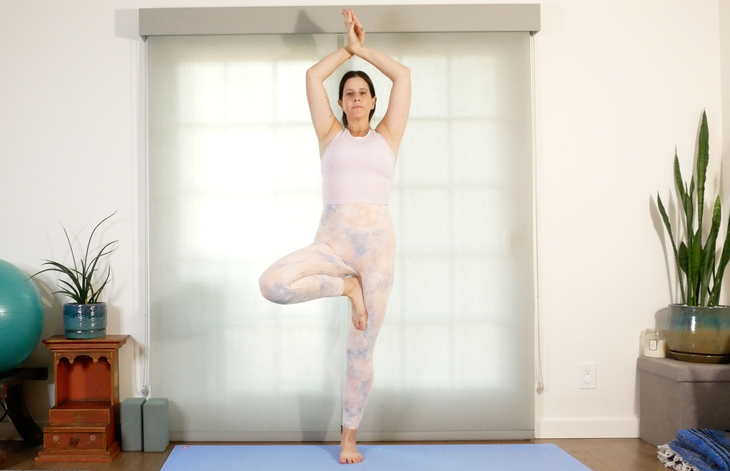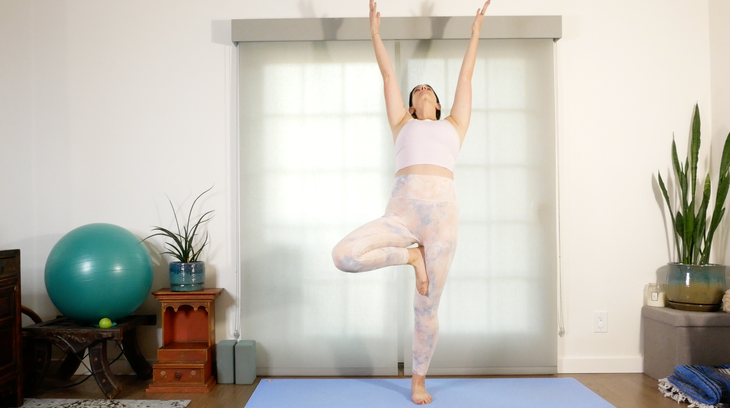“], “filter”: { “nextExceptions”: “img, blockquote, div”, “nextContainsExceptions”: “img, blockquote, a.btn, a.o-button”} }”>
Even people who have never stepped foot on a yoga mat or into a yoga studio know Vrksasana, Tree Pose. It might be one of the most familiar yoga postures that exists. You’ll see models standing one leg in television commercials for auto insurance and in bank ads on the sides of buses. It’s what preschoolers learn in school when they’re first introduced to yoga. Target mannequins do it.
It is also likely to be one of the first balance poses you ever practice, as it is regularly taught in introductory classes. In addition to being widely known, Vrksasana is a wildly versatile pose. It offers several options for the position of your lifted leg and your hand position. You can even do Tree on your back.
But Tree is far from an easy pose. It requires an advanced attention to balance because, contrary to what you might think, balance is not as simple as standing on one leg. In this asymmetrical position, it’s about finding an equal distribution of your body weight. You may assume that doing Tree Pose “right” means holding perfectly still, but when you attempt to hold yourself up on one foot, you feel the teetering and calibrating that the body must do to resist gravity. Balance is a moving target, rather than a fixed point.
You may also have the impression that if you can’t put your heel at the top of your thigh, you aren’t doing the pose correctly. Not so. A well-aligned Tree Pose has nothing to do with how high your lifted foot goes. It is one where you find just the right amount of opposing actions to bring yourself into balance. Your foot presses into your thigh or calf; your thigh or calf pushes back.
Finding Equilibrium in Tree Pose
Tree invokes an awareness of cause and effect. In the traditional pose, if you are standing on your right leg, your left foot is on your right inner ankle, calf, or thigh with your arms reaching skyward in line with your ears. When you push your lifted foot too hard, your standing hip juts out to the side and throws you off balance. If you shift your standing hip inward too far, your lifted foot may slide off your standing leg bringing you out of the pose, or your opposite hip can lift up, which can create an uneven spinal alignment. Both actions make for a lopsided tree, which can affect your breathing and your lower back. Likewise, if you reach too far with your arms, your lower back may arch, but if you lengthen your lower back too much, your tree may appear droopy.
Perhaps the most poignant lesson we can learn from Tree Pose is the same one we learn from trees: we are all connected. Peter Wolleben, author of The Hidden Life of Trees says trees exist along what he calls the “wood-wide web.” It seems that no matter the size of the tree or the forest, trees are all connected to one another, just as we are to one another and to all things.
Variations of Vrksasana
Getting Into Tree Pose
Start in Tadasana (Mountain Pose). Bend your right knee and pull your thigh toward your chest. Open your right knee to the side and place your right foot on your left ankle, inner calf, or inner thigh. Hug your left hip and your right foot in toward your midline. Place your hands on your hips and take a moment to level your pelvis side to side. If you feel balanced, reach your arms up in line with your ears.
It is okay to need help with balance in your poses; support for Tree Pose can come in many forms. To practice Tree against a wall, stand sideways with your standing leg near it and press your palm on it. This steadying force may boost your confidence to come into the pose.
Your gaze or drishti, also has an enormous influence on your balance, too. You can look down to the floor in front of you, directly ahead, or up at your hands. Just pick a still spot and keep your gaze steady.
Explore simply being in the pose for 5 breaths. Allow yourself to sway and feel all the actions that your body employs to keep you balanced. For example, the toes may grip or spread out on the floor. Notice how your spine gently undulates with your inhalations and exhalations. To come out of the pose, lower your right foot to the floor. Ground for a moment before repeating with your left.

Tree with Shiva Arms
Two intertwined branches are stronger than one out on its own. Reaching your arms above your head and crossing your forearms adds in an extra layer of attention and agility to your practice. This variation is called Shiva arms, named for the god who is said to have created yoga in traditional yogic texts.
How to: To do Shiva arms, lift your arms above your head. Cross your wrists, then turn your palms inward and press them firmly together. You may bend your elbows out to the sides for more space in your neck. When you practice on the other side, switch which hand is in front.

Tree With a Backbend
Thus far we have played with our limbs, or rather our branches, but we can also explore different shapes with our trunks too! Just as you can train a tree to form an arch, you can arch in Vrksasana, too. In the traditional Tree Pose we seek a spine that is neutral, maintaining all of our natural curves. In this variation, we will add in a backbend.
How to: Come into Tree pose with your spine straight and your arms in line with your ears. Slowly on an inhale, start to lift your chest upwards and lean back with your torso. Shift your gaze upwards to encourage the arch all the way into your neck, though take care not to drop your head back. Feel free to explore having your arms a little further apart so your chest can open even more broadly.

Tree With a Side Bend
Trees lean. Trees slant. Adding a side bend to Tree Pose allows us to get out of the confines of traditional alignment.
How to: In this variation, allow your pelvis to tip toward the standing leg as you curve your spine toward your bent knee. You can keep both arms overhead as though you are swaying your branches or you can rest one elbow on your bent knee thigh and just reach the top arm overhead.
Other Ways to Practice Tree Pose
Tree With a Chair and Wall
Remember, balance is as much a mindset as it is a physical experience. Think of using additional props—a chair or the wall—the way arborists use wooden stakes and ropes to help hold trees up. Your props are there as support.
How to: For this variation, stand with your back against the wall. Place the chair seat on your right side. Place a blanket or bolster on the chair for comfort when you rest your shin there. Lift your right leg up, bend your knee, and turn your leg out, resting your right shin on the chair. You can lift your arms if you feel stable. You will have to move the chair between sides.
Supine Tree Pose
You don’t have to be standing to be a tree. You can also seek balance while lying on your back by using the floor as feedback to level your pelvis.
How to: Lie on your back. Bend your right knee and pull your heel up your left inner thigh, then open your knee out to the right. When you bring your right leg up, your pelvis tends to tip toward that side. Working to level your pelvis will help you learn how to engage your obliques (side abdominal) muscles and gluteus medius (outer hip) muscles. When you’re ready, extend your right leg and practice on the opposite sides.
RELATED: No, You’re Not Doing Anything Wrong When You Sway In a Balancing Pose
About Our Contributor
Sarah Ezrin is an author, world-renowned yoga educator, popular Instagram influencer, and mama based in the San Francisco Bay Area. Her willingness to be unabashedly honest and vulnerable along with her innate wisdom make her writing, yoga classes, and social media great sources of healing and inner peace for many people. Sarah is changing the world, teaching self-love one person at a time. She is also the author of The Yoga of Parenting. You can follow her on Instagram at @sarahezrinyoga and TikTok at @sarahezrin.

